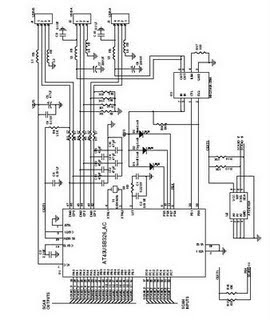The Atmel sample version of the AT43USB326 contains firmware
that supports customization of the Vendor ID, Product ID,
String Descriptor and the keyboard matrix. This information
is stored in an external AT24C02A serial EEPROM.

The Atmel AT43USB326 is an 8-bit microcontroller based on the
AVR RISC architecture. By executing powerful instructions in
a single clock cycle, the AT43USB326 achieves throughputs
approaching 12 MIPS. The AVR core combines a rich instruction
set with 32 general-purpose working registers. All 32 registers
are directly connected to the ALU allowing two independent
registers to be accessed in one single instruction executed in
one clock cycle. The resulting architecture is more code efficient
while achieving throughputs up to ten times faster than
conventional CISC microcontrollers.
Features
• AVR® 8-bit RISC Microcontroller with 83 ns Instruction Cycle Time
• USB Hub with One Attached and Two External Ports
• USB Keyboard Function with Three Programmable Endpoints
• 16 KB Program Memory, 512 Bytes Data SRAM
• 32 x 8 General-purpose Working Registers
• 32 Programmable I/O Port Pins
• Support for 18 x 8 Keyboard Matrix
• Keyboard Scan Inputs with Pull-up Resistor
• Four LED Driver Outputs
• One 8-bit Timer/Counter with Separate Pre-scaler
• External and Internal Interrupt Sources
• Programmable Watchdog Timer
• 6 MHz Oscillator with On-chip PLL
• 5V Operation with On-chip 3.3V Power Supply
• 48-lead LQFP Package
http://www.atmel.com/dyn/resources/prod_documents/doc3313.pdf

